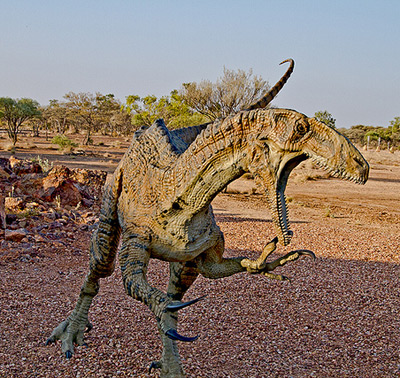
|
Search JoyZine with Google Site Search! |
Australovenator
Australovenator (meaning "southern hunter") is a genus of allosauroid theropod dinosaur from Albian-age (Early Cretaceous) rocks of Australia. It is the most complete skeleton of a meat-eating dinosaur ever found in Australia. Australovenator was a medium-sized allosauroid. According to Hocknull, it was 2m tall at the hip and 6m long, with a weight of about 500-1000k. Because it was a lightweight predator, he coined it as the "cheetah of its time". Like other carnosaurians, Australovenator would have been a bipedal carnivore. Fossil remains of theropods (carnivorous dinosaurs) number only a few in Australia, with all discoveries being represented by only one or two bone fragments. Australovenator is based on AODL 604, a partial skeleton (affectionately named "Banjo" after Banjo Paterson) including a left dentary, teeth, partial forelimbs and hindlimbs, a partial right ilium, ribs, and gastralia. Also found at the site were the type specimen of the sauropod Diamantinasaurus, bivalves, fish, turtles, crocodilians, and plant fossils. The Winton Formation had a faunal assemblage including bivalves, gastropods, insects, the lungfish Metaceratodus, turtles, the crocodilian Isisfordia, pterosaurs, and several types of dinosaurs, such as the sauropods Diamantinasaurus and Wintonotitan, and unnamed ankylosaurians and hypsilophodonts. Plants known from the formation include ferns, ginkgoes, gymnosperms, and angiosperms. Australovenator was described in 2009 by paleontologist Scott Hocknull of the Queensland Museum, and colleagues. The type species is A. wintonensis, in reference to nearby Winton. A phylogenetic analysis found Australovenator to be an allosauroid carnosaurian, with similarities to Fuiraptor (from Japan) and carcharodontosaurids. In the initial analysis, it was shown to be the sister taxon of the Carcharodontosauridae. More detailed studies found that it formed a clade with several other carcharodontosaurid-like allosaurs, the Neovenatoridae. It was described in 2009 as light of weight and built for speed, and placed in a brand new genus of theropod dinosaur. Studies of Banjo’s bones have revealed that Australovenator shared many features with primitive allosaurs, whilst also possessing features found in a more advanced theropod group, called the carcharodontosaurids. The Carcharodontosauridae is a family of theropod dinosaurs found in Europe, North America, South America and Africa, the most primitive of which is Neovenator from southern England. Based on the features shared between Australovenator and other more primitive allosauroids, as well as features shared with Neovenator, it is possible to place Australovenator on the family tree of allosaur theropods. Australovenator was most likely the descendant of Fuiraptor and the ancestor to Neovenator. Twenty eight years ago a dinosaur bone was discovered near Eagles Nest in southern Victoria. Once prepared, the bone was immediately recognisable as an astragalus (ankle) of a theropod dinosaur. In 1981 it was thought to belong to a dwarf species of Allosaurus, based on very similar features it shared to the larger Jurassic-aged dinosaur, Allosaurus fragilis. Debate surrounding this one bone has swung back and forth in and out of favour of its identification as a specimen of Allosaurus. Now, twenty eight years later, we can confidently assign the astragalus to Australovenator. |
